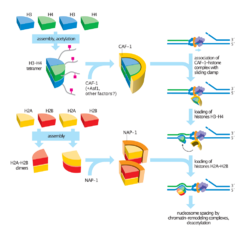Biology:Chromatin assembly factor 1
Chromatin assembly factor-1 (CAF-1) is a protein complex — including Chaf1a (p150), Chaf1b (p60), and p48 subunits in humans, or Cac1, Cac2, and Cac3, respectively, in yeast— that assembles histone tetramers onto replicating DNA during the S phase of the cell cycle.[1][2][3][4]
Function
CAF-1 functions as a histone chaperone that mediates the first step in nucleosome formation by tetramerizing and depositing newly synthesized histone H3/H4 onto DNA rapidly behind replication forks.[5][6][7] H3 and H4 are synthesized in the cytoplasm.[4] Several studies have shown that the interaction between CAF-1 and PCNA (proliferating cell nuclear antigen, which stabilizes CAF-1 at replication forks, is important for CAF-1's role in nucleosome assembly[8]
The three subunits work together to make the complex function. The human subunit (p150) interacts with PCNA, which acts as a sliding clamp, to help the CAF-1 complex interact with the DNA replication fork. Additionally, p150 along with PCNA performs nucleotide excision repair to fix any damaged DNA. P60 interacts with ASF1a/b, which is a histone chaperone for H3/H4. p48 has roles outside of CAF-1, but when involved with the complex, it binds to H4.[4]
p60 attracts ASF1a/b which is a chaperone for H3/H4 and this is in the complex with p150 which interacts with PCNA to attach to the replication fork. The CAF-1 complex adds the histones to the DNA ahead of the replication fork.[4]
A mutation in p150 that results in a loss of function would lead to double stranded breaks, interruptions in the replication fork and translocations. In p60, loss of function would mean the histone chaperone for H3/H4 would not interact with the complex. A mutation like this in either subunit would result in loss of function for the CAF-1 complex as a whole. However, loss of function in p48 would alter how well the complex is able to chaperone chromatin, but would not stop it as a whole.[4]
Roles
CAF-1 is required for the spatial organization and epigenetic marking of heterochromatin domains in pluripotent embryonic cells, creating a cellular memory of somatic cell identity during cellular differentiation.[9]
Cells resembling 2-cell-stage mouse embryos (totipotent cells) can be induced in vitro through downregulation of the chromatin-assembly activity of CAF-1 in embryonic stem cells.[10]
CAF-1 forms a deadenylase complex with CCR4-Not, which should not be confused with the unrelated CCR4. The CAF-1/CCR4-Not complex cooperates with the release factor eRF3 and PABPC1 to shorten the poly(A) tail of mRNA during translation.[11]
References
- ↑ Fang, Dong; Han, Junhong (2020-11-06) (in en). Histone Mutations and Cancer. Springer Nature. ISBN 978-981-15-8104-5. https://books.google.com/books?id=zGcHEAAAQBAJ&dq=cac1+vs+chaf1a&pg=PA23.
- ↑ "Purification and characterization of CAF-I, a human cell factor required for chromatin assembly during DNA replication in vitro". Cell 58 (1): 15–25. July 1989. doi:10.1016/0092-8674(89)90398-X. PMID 2546672.
- ↑ "Chromatin assembly factor 1 is essential and couples chromatin assembly to DNA replication in vivo". Proceedings of the National Academy of Sciences of the United States of America 100 (21): 12183–12188. October 2003. doi:10.1073/pnas.1635158100. PMID 14519857. Bibcode: 2003PNAS..10012183H.
- ↑ 4.0 4.1 4.2 4.3 4.4 Volk, Andrew; Crispino, John D. (August 2015). "The role of the chromatin assembly complex (CAF-1) and its p60 subunit (CHAF1b) in homeostasis and disease". Biochimica et Biophysica Acta (BBA) - Gene Regulatory Mechanisms 1849 (8): 979–986. doi:10.1016/j.bbagrm.2015.05.009. ISSN 0006-3002. PMID 26066981.
- ↑ "The Cac1 subunit of histone chaperone CAF-1 organizes CAF-1-H3/H4 architecture and tetramerizes histones". eLife 5: e18023. September 2016. doi:10.7554/eLife.18023. PMID 27690308.
- ↑ "Insights into the molecular architecture and histone H3-H4 deposition mechanism of yeast Chromatin assembly factor 1". eLife 6: e23474. March 2017. doi:10.7554/elife.23474. PMID 28315525.
- ↑ "DNA-mediated association of two histone-bound complexes of yeast Chromatin Assembly Factor-1 (CAF-1) drives tetrasome assembly in the wake of DNA replication". eLife 6: e22799. March 2017. doi:10.7554/eLife.22799. PMID 28315523.
- ↑ "PCNA connects DNA replication to epigenetic inheritance in yeast". Nature 408 (6809): 221–225. November 2000. doi:10.1038/35041601. PMID 11089978. Bibcode: 2000Natur.408..221Z.
- ↑ "CAF-1 is essential for heterochromatin organization in pluripotent embryonic cells". PLOS Genetics 2 (11): e181. November 2006. doi:10.1371/journal.pgen.0020181. PMID 17083276.
- ↑ "Early embryonic-like cells are induced by downregulating replication-dependent chromatin assembly". Nature Structural & Molecular Biology 22 (9): 662–671. September 2015. doi:10.1038/nsmb.3066. PMID 26237512.
- ↑ "Mechanism of mRNA deadenylation: evidence for a molecular interplay between translation termination factor eRF3 and mRNA deadenylases". Genes & Development 21 (23): 3135–3148. December 2007. doi:10.1101/gad.1597707. PMID 18056425.
Further reading
- "The histone chaperone CAF-1 safeguards somatic cell identity". Nature 528 (7581): 218–224. December 2015. doi:10.1038/nature15749. PMID 26659182. Bibcode: 2015Natur.528..218C.
- "Memory loss enables the production of stem cells". ScienceDaily (Press release). December 9, 2015.
- "Histone chaperone CAF-1: essential roles in multi-cellular organism development". Cellular and Molecular Life Sciences 72 (2): 327–337. January 2015. doi:10.1007/s00018-014-1748-3. PMID 25292338.
- "Want reprogramming? Cut back on the chromatin assembly!". Nature Structural & Molecular Biology 22 (9): 648–650. September 2015. doi:10.1038/nsmb.3081. PMID 26333710.
- "Chromatin dynamics after DNA damage: The legacy of the access-repair-restore model". DNA Repair 36: 114–121. December 2015. doi:10.1016/j.dnarep.2015.09.014. PMID 26429064.
- "Chromatin assembly factor 1 suppresses epigenetic reprogramming toward adaptive drug resistance.". Journal of the National Cancer Center 1 (1): 15–22. March 2021. doi:10.1016/j.jncc.2020.12.003.
- "Mechanistic insights into histone deposition and nucleosome assembly by the chromatin assembly factor-1". Nucleic Acids Research 46 (19): 9907–9917. November 2018. doi:10.1093/nar/gky823. PMID 30239791.
 |


